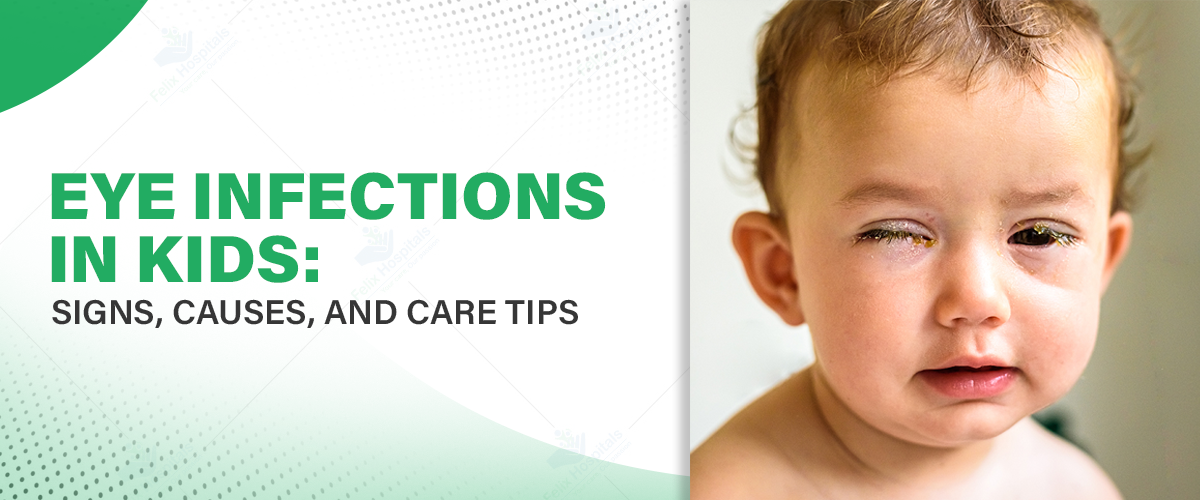
Subscribe to our

As a parent, it is always a concern when your child is not doing well—especially when it pertains to their eyes. Eye infections are common among children, often resulting in redness, discomfort, and even issues with vision. The silver lining? The majority of eye infections can be cured with the proper treatment and do not cause permanent damage. If problems persist, visiting the best eye hospital near me can help your child receive appropriate medical care.
Here's all that you need to know about eye infections in children, their symptoms, causes, and how to manage them the best.
Consult expert advice on pediatric eye infections and the best treatment from Felix Hospitals. Call Now for Help at +91 9667064100.
Eye infection happens when germs, bacteria, or viruses infect the conjunctiva that covers the eye, eyelids, or the eye. Eye infections result in swelling, inflammation, and temporary loss of vision. Kids are also bound to suffer from eye infections as they tend to touch the eye more.
There are several eye infections that typically affect children, and they have various symptoms and causes. If you want the best eye infection treatment in Noida, understanding these types can help you receive proper treatment.
Conjunctivitis is the most frequent eye infection in children. It occurs when the thin membrane covering the white of the eye and the eyelid lining becomes inflamed.
A stye is a painful red swelling at the base of an eyelash caused by infection of an oil gland or hair follicle.
Blepharitis is inflammation of the eyelids, usually with infection or skin disease such as eczema or rosacea.
Keratitis is the infection of the cornea, or the clear portion of the eye, and is dangerous unless treated. Although it happens infrequently in children, it may lead to a vision issue.
Unhygienic contact lens use
Cellulitis is an infection of the skin surrounding the eyes. Orbital cellulitis is tissue behind the eye, and preseptal cellulitis is tissue in front of the eye.
Although most eye infections heal with over-the-counter medication, you should consult with a doctor if:
Children's eye infections can develop very quickly, that is why early treatment should be done to prevent complications. Take your child to see a doctor immediately if he or she shows any concerning signs.
Most eye infections in kids are treated by simple home care. To help your child recover in a short while, follow the following:
If you observe symptoms of an eye infection in your child, you must seek professional medical attention. At Felix Hospitals, we are equipped with expert ophthalmologists specialized in pediatric eye infections:
Leave your child's eyes in the safe hands of Felix Hospitals' finest doctors.
Schedule an appointment with our award-winning pediatric ophthalmologists at Felix Hospitals today for early diagnosis and optimum treatment!
Eye infections among children are painful in nature, but with good care and attention, most of the illnesses can be treated very well. From bacterial infections like conjunctivitis to conditions like styes and blepharitis, one needs to know the symptoms and seek medical assistance when necessary. Don't forget, maintaining good personal hygiene, washing the eyes properly, and following a doctor's advice can make the recovery process fast and safe for your child. If you have a concern with the expense of treating eye infection, talk with your physician to determine what is available and what your child will need to do in order to get the best treatment.
Q- Can eye infection cause lasting vision issues in children?
Ans- A majority of eye infections resolve when they are given proper care, but untreated infection such as keratitis or orbital cellulitis may cause complications. Prompt medical intervention is required.
Q- How do I know if my child's eye infection is viral or bacterial?
Ans- Viral infections are watery eyes with redness, and bacterial infections are thick yellow or green discharge. A trained physician can diagnose and prescribe the appropriate treatment.
Q- Can I treat my child's infection using over-the-counter eye drops?
Ans- Not all eye drops are safe for children. Some infections require antibiotic drops, some antihistamine or lubricating drops. Always consult a doctor before taking any medication.
Q- How long does it take for an eye infection in children to heal?
Ans- The duration depends on the type of infection. Bacterial conjunctivitis improves within 3–5 days with antibiotics, while viral infections take up to two weeks to improve.
Q- Can my child attend school with an eye infection?
Ans- If the infection is infectious, e.g., bacterial conjunctivitis, it is best to keep your child at home until the symptoms resolve to prevent passing the infection on to others.
Q- What can I do if my child continually develops recurring eye infections?
Ans- Continuous eye infection could be a sign of an underlying condition, including allergies, hygiene problems, or a compromised immune system. The reason can be diagnosed by a pediatric ophthalmologist.
Q- Are there any home remedies that can help soothe pain from an eye infection?
Ans- Warm compresses, proper hygiene, and saline irrigations can be helpful but should not replace medical treatment if symptoms worsen or become prolonged.